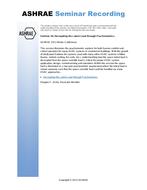Click here to purchase
Coupling building performance simulation with mathematical optimization offers a promising solution to minimize energy use in buildings. However, uncertainties due to occupants are rarely considered in this process. To address this issue, this paper examines the effect of integrating stochastic occupant behavior models in building performance optimization. A single office model was simulated under two scenarios; 1) using deterministic operational schedules as specified in ASHRAE Standard 90.1, and 2) using multiple stochastic models to simulate occupant behavior. A genetic algorithm was then applied to optimize energy use under each scenario. The results of each scenario show similar annual energy use, but significantly different optimal parameters, thus illustrating the importance of more detailed occupant modeling. These findings are highly relevant to researchers and practitioners as they highlight the importance of accounting for the effect of building design on occupants’ energy-related actions, when optimizing building performance.
Citation: 2019 Winter Conference, Atlanta, GA, Conference Papers
Product Details
- Published:
- 2019
- Number of Pages:
- 10
- Units of Measure:
- Dual
- File Size:
- 1 file , 1.9 MB
- Product Code(s):
- D-AT-19-C012


